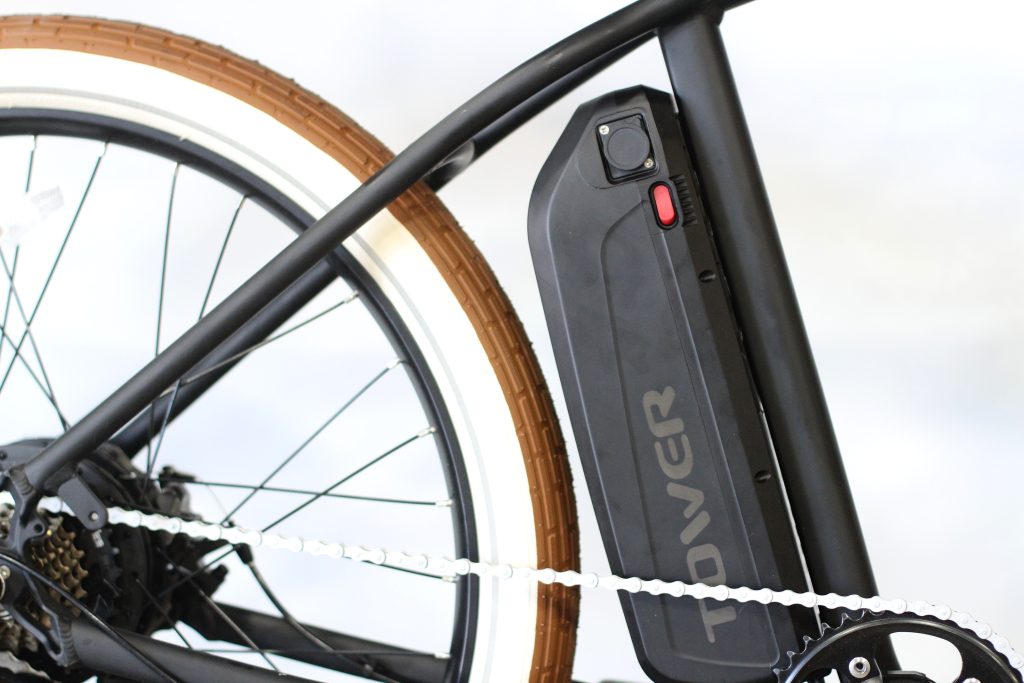Ebike batteries explained | beginner’s guide
Let’s start at the beginning, an ebike’s electric motor, is powered by a battery system, which is essentially the ebike’s fuel.
An ebike’s battery is ultimately it’s most important and most expensive part.
Choosing the right battery is important, especially if you plan on using your ebike for longer distances, over rough terrain or uphill a lot! You’ll need a higher performing battery if you’re going to make your ebike work hard for regularly.
Ebike battery measurements explained
It’s important to try and grasp the electrical measurement terminology used to determine rebuke battery performance.
It may feel a little bit like your back at school doing GCSE physics but bear with us, we’ll try and keep it simple, brief and why it’s important in relation to your ebike battery…
Voltage (V)
Volts “v” are recognised internationally as a unit for measuring electrical potential or force. To get really technical it’s the potential difference between two points that are conducting current.
The term “voltage” is used to characterise the velocity of electrons; a higher voltage indicates a faster velocity. Voltage is what pushes the electricity along, making it flow.
Hence why the higher voltage your ebike battery is, the faster it can go. Voltage is basically how fast electrons move, higher volts means higher speed!
Ebike batteries can be 24V, 36V or 48V, however they’re usually 36V or 48V.
The higher volts of your ebike battery means more power and more speed. Potentially.
We say potentially, as there are other contributing factors, as you could have a lower voltage but still a high performing ebike.
Amps (short for Amperes)
The electrical current unit is called an amp. Again, it’s an internationally recognised measurement.
The simplest way to define amp is a unit of electrical current.
You’ll find a common analogy of water flowing through pipes when people talk about amps. The Amps are like the thickness of the water pipe and can therefore carry more water or power.
Amp Hours (Ah)
This is one spec of your ebike battery that you want to look out for, it’s basically your petrol tank and defines the range of your ebike.
Your battery’s Amp Hours are important for understanding your ebike’s range, but how you ride, what you carry, uphill / downhill, etc will determine your range a lot!
Basically, if you pedal more, you’ll get better range. If you go downhill more than uphill, you’ll get better range
Watts (W)
Another international standard unit of power. Watts are used to describe the rate at which electrical energy is used up or dissipated.
In simple terms, your ebike will create more power the greater the wattage.
Watts are usually applied for ebike motors, usually 250w, 500w or 750w. UK law states that ebikes are road legal when they’re 250w, anything bigger is an electric motorcycle or moped.
Watts per hour (Wh)
This is a biggy when it comes to understanding your ebike battery, it’s about the energy that can be stored by your battery and is important for range again.
Wh is the combo of your ebike battery’s volts and amp hours.
Ebikes usually come between around 300Wh and 1,000Wh.
So a 500Wh ebike battery, can power a 500w ebikes for 1 hour – hence 500 Watts per hour.
If your ebike is a road legal 250w version, then if it comes with a 500Wh battery, it can deliver 250w for two hours.
You can calculate the Watts per hour of your ebike’s battery by multiplying the Voltage by the Amp Hours.
Watts per hour are important as they factor in the Voltage and the Amp Hours.
Your ebike battery important measurements summarised
So your ebike battery important measures are:
Voltage (V), higher voltage = higher power / speed
Amp Hours (Ah), higher Ah = better range
Watts per hour (Wh), higher Wh = better run time
Let’s look at a few examples of poplar ebike batteries
Super73 ZX: 615 Wh | 48v | 12.8ah
Vanmoof S5: 487 Wh | 47v |
Mate X:

Different ebike battery types
The ebike market has a few different battery types, these include Lead Acid, Lithium-ion, Lithium-ion Polymer, Cobalt-Lithium, Lithium Manganese, Nickel-Cadmium and Nickel-Metal Hydride. However, the first three are generally the most common, let’s go into the details…
Lead Acid ebike batteries
If you can’t see what type of battery your ebike has on the specs, then you can probably assume it’s a Lead Acid battery, especially if you’re buying a cheapish ebike.
Lead Acid is the cheapest ebike battery, and were the original battery used.
Like most things, the cheapest isn’t the best, as Lead Acid batteries are around three times heavier than Lithium-ion batteries and we all know what more weight means on your ebike, yep, less range.
Lithium-ion ebike batteries
Lithium-Ion batteries are the most popular battery used for ebikes, as they provide the best range and longevity, with a good balance between weight and performance.
Lithium is the lightest metal and is great at storing energy, which is what makes it so good for using in batteries.
They dominate the market and you’ll find the same technology in your regular household items all the way to top performing electric vehicles such as Tesla!
Lithium-Ion batteries should last between three to five years if they are cared for properly and well maintained, but could last as long as eight if you’re really careful (and lucky).
Lead-acid batteries were first used in electric bike batteries as they are significantly cheaper however they are three times as heavy as Lithium-Ion batteries.
Lithium-ion Polymer ebike batteries
Lithium-ion Polymer batteries used a polymer electrolyte instead of a liquid electrolyte.
They’re extremely light and are often found in devices where they need a light battery such as mobiles or RC planes and drones.
Hence why they’re great for ebikes when everyone is striving for a greater range and load can have a negative effect on this.
Cobolt-Lithium ebike batteries
A little bit longer than Lithium Manganese batteries, it has been available on the market. It has a higher energy density than regular lithium batteries. It also offers the most power, is portable, and is dependable.
Lithium Manganese ebike batteries
It’s the newest Lithium-ion battery available. They have a good range and are long-lasting. The manufacturers also claim that they have a longer lifespan than other Lithium batteries. You’ll find plenty of electric car manufacturers using this battery type.
Nickel-Cadmium ebike batteries
Nickel-Cadmium batteries offer more capacity per pound than lead-acid batteries.
However, cadmium is an expensive and challenging to recycle hazardous pollutant, and nickel-cadmium is also expensive.
In contrast, NiCd batteries have a longer lifespan than lead-acid batteries.
However, NiCd batteries are becoming less useful as a result of how difficult they are to recycle or properly dispose of. They release themselves at an astonishingly high rate.
They can degrade by as much as 70% in just 24 hours after a full charge and no use. Their electricity density is low. These are not a suitable battery type option, regardless of price.
Nickel-Metal Hydride ebike batteries
NiMH batteries are more expensive than NiCd batteries despite being more effective. The vast majority of people assert that NiMh has little to no range advantage over NiCd. On the other hand, they will endure longer and are simpler to properly dispose of.
However, nickel-metal hydride batteries have a short lifespan. It might be challenging to charge them, and maintaining them in excellent operating order can be challenging.

How to take care of your ebike battery
- Ensure that the charger you are using is the appropriate one for your battery. Batteries will deteriorate over time, whether or not they are used, but a dodgy charger will shorten your ebike battery life but a poor quality charger can also be a fire hazard.
- Check the manufacturer’s recommended guidelines for storing, charging and caring for your ebike battery to optimise your particular battery type’s performance and lifespan.
- Avoid handling batteries roughly or carelessly to prevent vibration and shock which can damage the battery and can both shorten their lifespan.
- You shouldn’t leave a lithium battery plugged in after it has finished charging as it can damage battery life. Smart charging systems should prevent overcharging these days but if you can unplug after it has reached full charge then you should do so.
- If you ride all year long and frequently in extremely cold conditions, you could consider investing in a battery cover.
Ebike battery FAQs
Can you overcharge an ebike battery?
Most modern ebikes are built with smart charging functionality, which means it’s impossible to overcharge them.
However, if you bike hasn’t got this, it’s important to try not to overcharge your ebike battery otherwise you can shorten its lifespan.
Can you replace a battery on an ebike?
One of the main benefits of an ebike is being to remove, recharge, replace or keep a spare battery.
If the battery on your ebike starts to show signs of wearing out, like your three year old iPhone, then the beauty of an ebike is that you can simply replace the battery.
You can even keep your older, more tired ebike battery as a spare.
How many times can you recharge an ebike battery?
Most reputable ebike manufacturers will provide e-bike battery that will endure hundreds, if not thousands of recharges to provide you the power you need to get through your daily commute.
How long does an ebike battery last?
An ebike battery should last anywhere between three to five years if you look after it.
However, if you want to know how long will it last when in use rather than its lifespan, then it will depend on lots of variables… These include your ebike motor power, how you ride, where you ride, how much weight your bike is carrying etc
You should see around 50 miles or a couple of hours from your ebike battery when it’s fully charged.
Can I upgrade my ebike battery?
The simple answer to this is yes, most of the time, but how and when you do will depend on which ebike you own.
Many ebikes have the ability to have different batteries and spares, so you will be able to chop and change, increasing the battery specs ie Volts, Amp Hours and Watts per Hour on what is available for your particular manufacturer.
Some more high-end ebikes often have a high spec battery already and would need to replaced by the manufacturer to maintain any warranty.
However, as battery technology improves over time and your ebike lifespan is decreasing then you will want to upgrade to the latest best battery from your ebike manufacturer, who will continue to improve their offering. You’ve just got to hope their latest battery is compatible with the model that you own.
How much are ebike batteries?
The cost of an ebike battery can be anything between £200 to £1000 but what you can use will again depend on your ebike brand and manufacturer. You may need to pay for labour if you need the ebike battery replaced by a professional.
